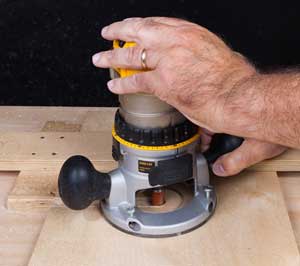
Is there a recommended way to clean up burns on wood from routers?
Michael Dresdner: I find that a sharp scraper works as fast as anything, but aluminum oxide sandpaper will do the trick too. Any way you look at it, you clean up burnt wood by removing it. How you remove it depends on the surface (curved or straight) and which tool you like best. By the way, you might want to prevent the burning instead. It indicates either a dull bit or too slow a feed rate (how fast the wood is pushed past the cutter) for that particular bit speed. Remember that what is important here is not just RPM, but tip speed?how fast the cutting tip is going. That changes depending on the size of the cutter.
For example, a 1/4″ diameter bit running at 20,000 rpm will have a tip speed of about 1308 feet per minute (fpm). A one inch bit at the same rpm will have a tip speed of about 5233 fpm. Big difference. (You calculate tip speed by multiplying the diameter of the bit times pi [to get the circumference] then multiply that by the rpm. That gives you inches per minute. Divide by 12 to get feet per minute.) The larger bit is more likely to burn at a slow feed rate. When you get into panel raising bits, whose outside tip may be as much as 3″ across, you really get into some problems. A 3″ bit on a 20,000 rpm spindle has a tip speed of about 15,700 fpm?or about 178 miles per hour. Whew!
Simon Watts: Scraping burn marks out is the only way I know. Sanding is less effective.





